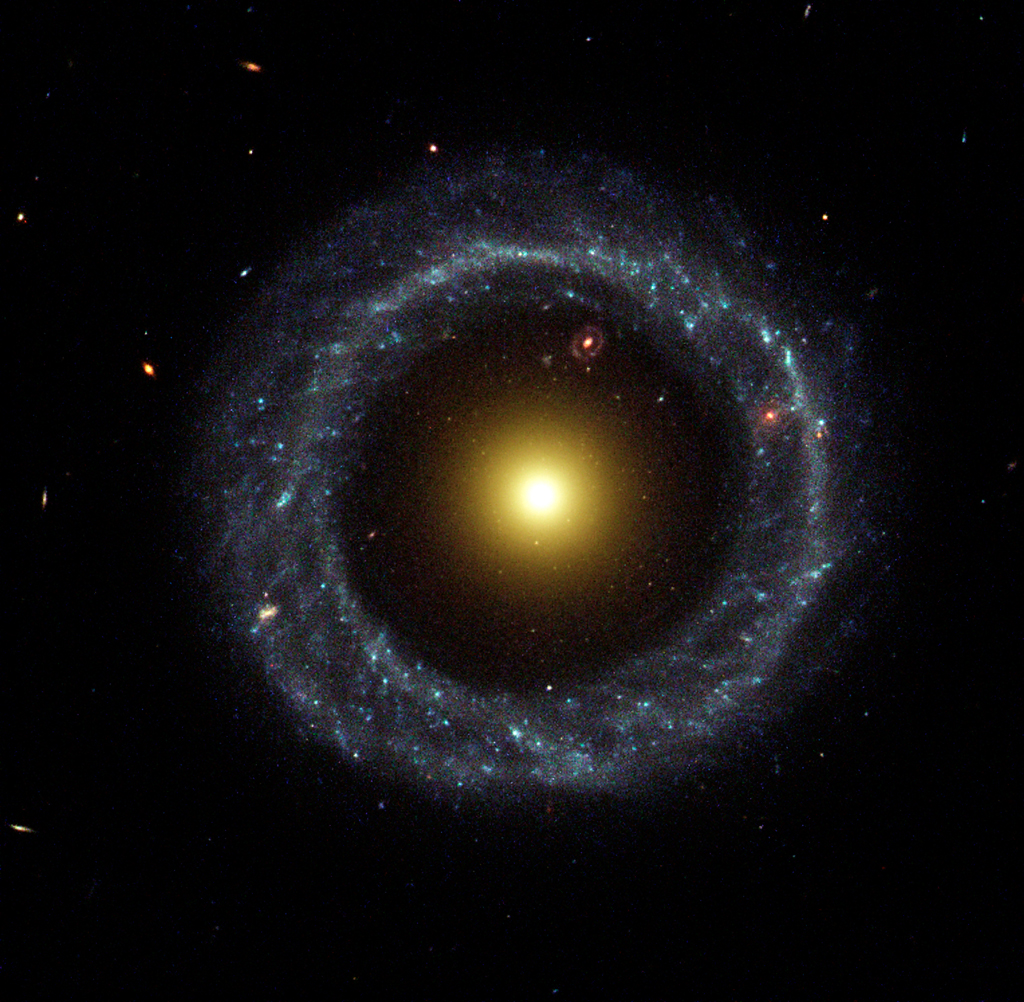
Key Takeaways:
There are “ring galaxies” that slightly resemble Hoag’s Object because their peripheries are much brighter than their interiors. However, none have a ring that surrounds emptiness that in turn surrounds a giant yellow ball of suns.
Beyond its bizarre appearance, the real mystery is how this kind of configuration could have ever arisen. Unfortunately, one idea after another has been proposed and then rejected. Other “classic” ring galaxies are believed to have resulted from a large disk-shaped spiral galaxy being penetrated and tidally disrupted by an invading companion. Collisions of this sort either result in wild distortions like M82 or the Antennae Galaxies or a merger into a new elliptical shape like that of M87. Collisions can also create density waves, which computer simulations show can sometimes produce a bright outer ring. But a ring surrounding nothingness?
Some think Hoag’s Object resulted from a small galaxy passing through a larger one like a cannon ball, 2 to 3 billion years ago. But the lack of any candidates in the vicinity, plus the slow spin of the core compared to the motions of the ring, makes most astronomers reject this hypothesis. One scientist thinks a barred galaxy can go through extreme instability that brings about this shape, while others point out that, if that were the case, the nucleus would be disk-shaped rather than the ball now seen. Nothing fully works.
A few extremely rare so-called Hoag-type galaxies can be found with difficulty, but all have differences, like some trace of spiral structure, or a nucleus that has a bar or is elliptical or disk-shaped. Hoag’s Object is unique in the cosmos.
As if to tease us further, Nature has a final surprise. Despite their extreme rarity, a Hoag-like ring galaxy appears within Hoag’s own ring. In the picture above, between the core and the outer ring in the one o’clock direction, you’ll see a second ring galaxy! Hoag’s Object is so far away that its apparent width is only one quarter of an arcminute, resembling the tiny diameter of Mercury. What are the chances that another ring should appear within its own ring? It’s impossible, really. It can’t be there.
And yet, wheels within wheels, there it is. Galaxies are the largest things in the universe. Happily for us, they come in only a few varieties, making them easier to identify and theorize about. Nearly all are either elliptical (ball-shaped), irregular, or else spirals of various kinds. But a handful of oddballs fit none of these categories, and one galaxy stands all by itself.In 1950, astronomer Arthur Hoag came upon a tiny, faint, 16th-magnitude ring surrounding a ball-like center, and reasonably assumed it was a planetary nebula – a nearby puff of gas expelled from a single old-aged star. He also proposed an alternative and far more exotic explanation that this was an “Einstein Ring” from a faraway quasar. In this scenario, the quasar’s light is distorted into a halo by space-warping caused by a massive foreground spherical galaxy that it seems to surround. But later spectroscopic studies rejected this because the golden central ball and the blue ring have exactly the same redshift, indicating a whopping rush-away speed of 7,916 miles (12,740 kilometers) per second, which proves they’re both located exactly the same distance from us.Hoag also thought it possible that this was some sort of peculiar galaxy. And – as if to prove that if you make enough guesses, you increase your chance of success – his last surmise was right.
In 2002, the ultra-sharp optics of the Hubble Space Telescope revealed Hoag’s Object, as it is now called, as a perfect blue ring of stars, dust, and gas, complete with knotty clumps that are unresolved star clusters. In other words, yes, this is a galaxy. The problem, of course, is that Hoag’s Object does not assume the familiar spiral pattern, with arms wending their way inward to the older, yellower stars that make up nearly every galaxy’s nucleus. Instead, the nucleus sits all by itself in space. A whopping 70,000 light-years away from it, separated by near-nothingness, hovers that ring of billions of stars, planets, and who-knows what else.Hoag’s Object lies 600 million light-years away from us in the constellation Serpens Caput, the rear half of the writhing snake held by Ophiuchus the Serpent Bearer. Its inner yellow core is 24,000 light-years across, almost the same as the core of our Milky Way. The outer ring of Hoag’s Object, with a width of 120,000 light-years, is similar in size to our galaxy’s diameter. It’s almost as if some malevolent alien starship vacuumed up the middle sections of a galaxy but bewilderingly spared both the center and the outermost regions.









